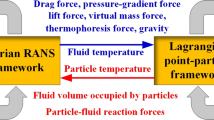Abstract
The article presents a method for calculating the process of the coagulation of particles, resulting from different degrees of velocity lag in a nozzle, and the results of calculations carried out by the methods of Euler and Lagrange. Both methods ensure a good degree of accuracy in a numerical calculation of the change in the degree of dispersion of particles in a nozzle. The process of the collision and coalescence of the drops of a condensate, resulting from different velocity lags of particles of different sizes, with the nonequilibrium flow of a two-phase stream in nozzles, is discussed in [1–5], There are two possible approaches to a description of the change in the degree of dispersion of a system of particles, i.e., the Euler and Lagrange methods [6]. The Euler method postulates a jumpwise growth of the particles, with the collision and coalescence of two drops. In this case, for particles of a definite fraction with a mass mi (i=1, ⋯, n), determinations are made of the decrease in the number of these particles in a unit of volume n(mi) due to entrainment of the particles resulting from their coalescence with drops of other fractions, and of the increase of n(mi) due to the formation of particles mi, with the coalescence of particles of the fractions m and (mi−m), where m=mi. This type of model was used in [2–5] for calculating the coagulation process of particles in a nozzle. In a more complete statement, nonequilibrium flow in a nozzle, taking account of collisions, coalescence, and of the exchange of energies and momentum between particles, is discussed in [3]. The Lagrange method for fixed i-particles considers a continuous increase in the mass mi as the result of coalescence with smaller j-drops (j=1, ⋯, i−1) and a decrease in the number of particles in unit volume ni, resulting from their absorption by larger particles (j=i+1,⋯, n). This approach is discussed in [1]. The present article gives below a method for calculating the coagulation process of particles in a nozzle using the Lagrange method, and analyzes the results of electronic-computer calculations, carried out using both of the above-discussed methods.
Similar content being viewed by others
Literature cited
C. T. Growe and P. G. Willoughby, “A study of particle growth in a rocket nozzle,” AIAA Journal,5, No. 7 (1967).
F. E. Marble, “Droplet agglomeration in rocket nozzles caused by particle slip and collision,” Astronaut. Acta,13, No. 2 (1967).
S. D. Grishin, A. P. Tishin, and R. I. Khairutdinov, “Nonequilibrium two-phase flow in a Laval nozzle with the coagulation of particles of a polydisperse condensate,” Izv. Akad. Nauk SSSR, Mekhan. Zhidk. i Gaza, No. 2 (1969).
P. Kuentzmann, “Agglomération des particules d'alumine dans l'écoulement de tuyere d'un propergol métallisé,” Rech. Aérospat, No. 131 (1969).
R. M. Jenkins and R. M. Hoglund, “A unified theory of particle growth in rocket chambers and nozzles,” AIAA Paper No. 69–541 (1969).
V. I. Belyaev, The Lagrange Method in the Kinetics of Cloud Processes [in Russian], Izd. Gidrometeoizdat, Leningrad (1964).
N. A. Fuks, The Mechanics of Aerosols [in Russian], Izd. Akad. Nauk SSSR, Moscow (1955).
Author information
Authors and Affiliations
Additional information
Translated from Izvestiya Akademli Nauk SSSR, Mekhanika Zhidkosti i Gaza, No. 5, pp. 181–185, September–October, 1971.
Rights and permissions
About this article
Cite this article
Tishin, A.P., Khairutdinov, R.I. Calculation of coagulation of particles of the condensate in a laval nozzle. Fluid Dyn 6, 898–902 (1971). https://doi.org/10.1007/BF01013877
Received:
Issue Date:
DOI: https://doi.org/10.1007/BF01013877




